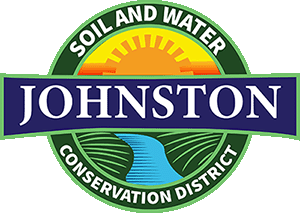
Soil and Water Conservation
Johnston County, North Carolina

Johnston County, North Carolina
The North Carolina Conservation Reserve Enhancement Program (CREP) is a voluntary land retirement program that helps agricultural producers protect environmentally sensitive land, decrease erosion, restore wildlife habitat, and safeguard ground and surface water. The program is a partnership between producers and tribal, State and Federal governments and, in some cases, private groups.CREP is an offshoot of the country's largest private-lands environmental improvement program - the Conservation Reserve Program (CRP). The purpose of CREP is to protect and improve water quality and wildlife habitat through implementation of forested riparian buffers, grass filter strips, and wetland restoration.
Like CRP, CREP is administered by the USDA's Farm Service Agency (FSA).CREP combines efforts of several USDA agencies, State agencies, Indian tribes, conservation and other private organizations, and citizens concerned about farmland conservation. By combining CRP resources with State, tribal, and private programs, CREP provides farmers and ranchers with a sound financial package for improving their operations. CREP addressed high-priority conservation issues of both local and national significance, such as agricultural runoff, loss of critical wildlife habitat, and soil erosion. CREP is community-based, centered around local participation and leadership. Project development begins with State, local, and tribal governments, which also contribute funding and technical support.
The result? A unique program that highlights specific community needs. For instance, several CREP partners are using the program to safeguard drinking water, while others are focusing on protecting wildlife and revitalizing rivers and bays.
CREP supports increased use of filter strips and forested buffers. These conservation practices help protect streams, lakes, and rivers from sedimentation and agricultural runoff. CREP also helps landowners develop and restore wetlands through planting appropriate ground cover. Ground cover improves soil, water and air quality, and also provides habitat for threatened and endangered wildlife species. By maintaining clear goals and requiring annual monitoring, CREP measures progress and ensures success.
CREP will help nutrient sensitive waters by:
For the landowner, CREP is not just a cost-effective way to address rural environmental problems and meet regulatory requirements, it can increase farm income as well. To encourage producers to join, States and private organizations involved in CREP frequently offer financial incentives in addition to those available with regular CRP. CREP is convenient for producers because it is based on the familiar, highly successful CRP model. Land must be owned or leased for at least 1 year to be eligible and must be physically and legally capable of being cropped in a normal manner. Enrollment can be on a continuous basis, permitting applicants to join the program at any time rather than waiting for a specific sign-up periods.
Like CRP, CREP contracts require a 10 to 15 year commitment to keep lands out of agricultural production, guaranteeing lasting benefits. Many States offer landowners additional incentives to enroll CREP land in permanent easements.
Enrollment Period:
Because CREP is community based, it is available only in designated areas within States or tribal lands that have developed CREP partnerships with USDA. Enrollment in a State is limited in size. To determine if your community is involved in CREP and if you may qualify, contact your local FSA office.
Qualifications for CREP Enrollment:
What types of trees will be planted on the forested riparian buffer?
A Forest Management Plan is written by the DENR Division of Forest Resources in agreement with the landowner and NRCS. It will indicate what trees are suitable for each CREP site and selection will be determined on a site by site basis.
There must be at least two different tree species, one being a hardwood, planted in the riparian forest buffer. The goal is to promote water quality and wildlife benefits, not timber production.
What are CREP conservation easements?
A CREP conservation easement is an acquired interest in land that restricts cultivation, development, and grazing.
Only the enrolled land will be included in the conservation easement. The landowner still owns, retains title, and has the right to control access to the land.
Land enrollment in CREP does not prevent you from:
The public does not have access to the land.
What management is allowed within the CREP riparian buffer practice?
The landowner may selectively harvest the stand of trees within the CREP buffer area as determined by the Forest Management Plan. However, no clearcutting is allowed while the land is enrolled in CREP.
A portion of CREP area, from the water course edge out to 50 feet, is considered a "no-cut" zone. Silvicultural practices necessary to maintain the health of individual trees are permitted within the 50-foot "no-cut" zone.
Management of the riparian buffer area must be in compliance with federal, state and local government regulations.
Information Provided by : Soil and Water Conservation
Page last updated on: January 7, 2019
Page last updated: July 22, 2022